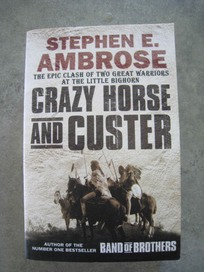Friday, 24 October 2008

Given an academic background that includes one subject examining the origins, course and aftermath of the American Civil War and another looking at race relations and frontier conflict it’d be hardly surprising if this title hadn’t caught my eye on one of my sporadic visits to big city bookstores.
To a long-time Neil Young fan, the life of a certain well-known leader of the Oglala Sioux would probably be a matter of some interest anyway, given the fact that Young’s long-time on-and-off backing band happens to be named after him.
On top of that I’m always interested to investigate the realities behind some of the figures who have had legends built up around them, and when it comes to legendary figures, there’s no doubt that the US military leader who met his end at the Little Bighorn fits into the category of names that most members of my generation would recognize.
Ambrose, author of a number of titles that fall more or less under the heading of military history tackles the lives of two significant figures by adopting a parallel chronology of their respective lives, culminating, predictably, in the events of 25 June 1876 at the Little Bighorn.
There may be some who’d find this approach to the subject unreasonable, given that we’re looking at two men from vastly differing societies whose respective lives contain far more points of difference than suggestions of similarity.
On the other hand, given the need to develop a narrative that delivers both characters to that fateful encounter I thought the approach worked. It also, coincidentally, allows the author a chance to contrast the two figures and to place them within their respective societies.
The fact that those societies were headed for unavoidable collision, and that Crazy Horse and Custer ended up at the scene of that collision makes the author’s approach an entirely satisfactory modus operandi.
On the other hand, presenting two lives in parallel makes it possible to present either of those lives unfavourably when contrasted with the other, and there’s no doubt in my mind that, of the two, Custer is presented in a far less favourable light than would have been the case had Ambrose decided to present the two lives as two separate narratives until the start of the campaign that culminated at the Little Bighorn.
Throughout the book, Crazy Horse comes across as the epitome of the noble savage, lacking any inclination towards self-aggrandisement. It’s a fairly easy picture to paint, given the comparative lack of detailed biographical information about the man.
Custer, on the other hand, always a controversial character, emerges from the contrast as a figure with considerable deficiencies in personality and temperament. Much of that could be attributed to the fact that the Civil War shot the man to a rank and reputation which would have been impossible under other circumstances.
Impulsiveness and disregard for consequences seem to have been the most significant elements in Custer’s character, so it’s hard to imagine the man achieving prominence in a peacetime army without the prospect of active service any time soon. Regardless of protection afforded by the West Point Old Boys’ network, you’d expect someone like Custer to have created plenty of animosity among his fellow officers, and he certainly did so in the aftermath of the Civil War. His reputation as the dashing Boy General helped him to maintain his position with the 7th Cavalry, but it must have been, like many of his battlefield experiences, a close run thing.
Given an overall familiarity with the main themes surrounding the events in the book without knowing too many details of the protagonists’ lives, I found the book an absorbing read, with the most interesting element to emerge from the narrative being the possibility that Custer’s actions that fateful day may have been part of his manoeuvring for the Democratic Party’s nomination for the 1876 Presidential election. That suggestion has, I gather, been put forward by other writers but was one I hadn’t previously encountered.
Overall rating: Worth a read if you’ve got a novice’s interest, though I have no way of knowing where it ranks in the voluminous literature associated with the subject area.